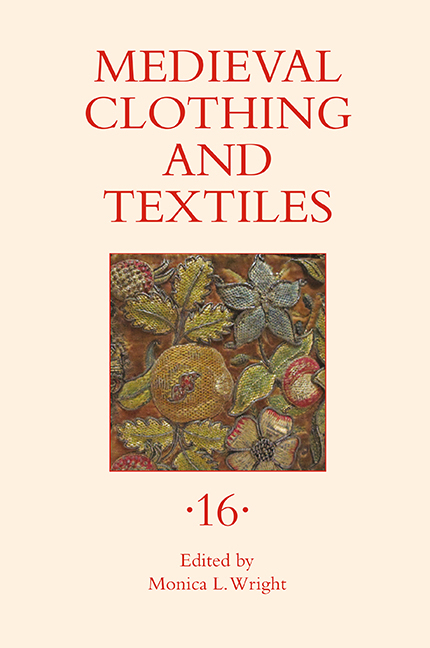Book contents
- Frontmatter
- Contents
- Illustrations
- Tables
- Contributors
- Preface
- 1 Anglo-Saxon Banners and Beowulf
- 2 The Use of Curved Templates in the Drawing of the Bayeux Tapestry
- 3 Construction and Reconstruction of the Past: The Medieval Nordic Textile Heritage of Hemp
- 4 Historicizing the Allegorical Eye: Reading Lady Mede
- 5 Sex, Lies, and Verdugados: Juana of Portugal and the Invention of Hoopskirts
- 6 Fashion and Material Culture in the Tabletop of the Seven Deadly Sins Attributed to Hieronymus Bosch
- 7 The Broderers’ Crown: The Examination and Reconstruction of a Sixteenth-Century City of London Livery Company Election Garland
- Appendix 7.1 Surviving Sixteenth-and Seventeenth-Century Embroidered Crowns of the City of London Livery Companies
- Recent Books of Interest
- Author Index, Volumes 1–15
Recent Books of Interest
Published online by Cambridge University Press: 27 March 2021
- Frontmatter
- Contents
- Illustrations
- Tables
- Contributors
- Preface
- 1 Anglo-Saxon Banners and Beowulf
- 2 The Use of Curved Templates in the Drawing of the Bayeux Tapestry
- 3 Construction and Reconstruction of the Past: The Medieval Nordic Textile Heritage of Hemp
- 4 Historicizing the Allegorical Eye: Reading Lady Mede
- 5 Sex, Lies, and Verdugados: Juana of Portugal and the Invention of Hoopskirts
- 6 Fashion and Material Culture in the Tabletop of the Seven Deadly Sins Attributed to Hieronymus Bosch
- 7 The Broderers’ Crown: The Examination and Reconstruction of a Sixteenth-Century City of London Livery Company Election Garland
- Appendix 7.1 Surviving Sixteenth-and Seventeenth-Century Embroidered Crowns of the City of London Livery Companies
- Recent Books of Interest
- Author Index, Volumes 1–15
Summary
Arrayed in Splendour: Art, Fashion, and Textiles in Medieval and Early Modern Europe, edited by Christoph Brachmann (Turnhout, Belgium: Brepols, 2019). ISBN 978-2503579658. 264 pages, 119 illustrations (111 in color).
This collection, based on a series of lectures at the University of North Carolina at Chapel Hill from 2011 to 2013, seeks to elevate the status of historical textiles in the art world to the way they were perceived at their creation—as very expensive, meaningful, and luxurious pieces of art—compared to their typical current ranking as a secondary or low form of art. There is a good deal of research presented in these essays to support this position and hopefully convince nonbelievers to reconsider their outlook. Herein lies the rub. No one needs to convince me that textile art is high art. Whether the arguments would convince a skeptic is not a question I can answer.
The volume consists of an introduction, eight papers, a useful glossary, biographies of the authors, a comprehensive bibliography divided into primary and secondary sources, and an index. The editor's introduction lays out the argument for elevating historical textiles to a higher level of art, describes the recent work being done on the topic, and summarizes each essay.
Six of the papers address periods covered by this journal. Evelin Wetter assesses the significance and use of textiles in ecclesiastical consecration rites from the twelfth through fourteenth centuries, highlighting an extant “nun's crown.” Christoph Bachmann covers the funeral garments of Holy Roman Emperor Charles IV (d. 1378) and family members, with particular emphasis on the iconography of the textiles. Lisa Monnas traces the evolution of cloth of gold in England and Italy from 1300 to 1550. Ulinka Rublack explores the use of fashion and color as the language of power and political symbolism at the 1530 Imperial Diet in Augsburg. Roberta Orsi Landini considers Cosimo I de’ Medici's use of textiles adorning both person and place in sixteenth-century Florence as a method to balance tradition with wealth and status while underscoring the ruler's power. Katja Schmitz-von Ledebur looks at the role of textiles, specifically tapestries, as exemplars of royal wealth and power, beginning with the Duke of Burgundy and continuing into the nineteenth century.
- Type
- Chapter
- Information
- Medieval Clothing and Textiles 16 , pp. 205 - 216Publisher: Boydell & BrewerPrint publication year: 2020



